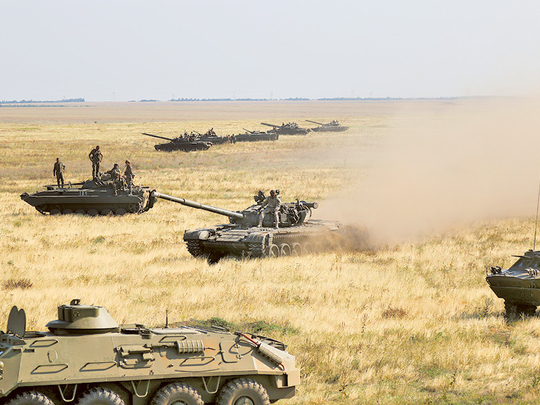
Moscow: Russia has deployed an advanced S-400 surface-to-air missile battery to the Crimean Peninsula amid escalating tensions there, according to Russian news reports. The missile system, once operational, would be able to target aircraft deep into Ukrainian airspace.
The deployment of the truck-mounted missile system has been planned at least since July, but its arrival in Crimea coincides with a flurry of military activity and rhetoric following claims from the Kremlin that two Russians were killed on the Crimean-Ukrainian border last week.
The S-400 can hit targets well over 150 miles (240km) from its launch site when paired with the appropriate radar array and is billed as one of Russia’s most advanced surface-to-air defence systems. The Crimean peninsula is currently home to the older S-300 Russian surface-to-air missiles that will likely be replaced by the arrival of the newer S-400s.
Between August 6 and August 8, the Russian Federal Security Service, or FSB, said it arrested Ukrainian saboteurs who had snuck over the border and also recovered a large cache of explosives in the town of Armyansk. During the arrest, one FSB agent was killed in an exchange of gunfire with the Ukrainian agents, according to a statement on the FSB’s website. The FSB also claimed to have repelled Ukrainian special forces attempting to infiltrate Crimea and in a subsequent cross-border shelling, one Russian soldier was apparently killed.
Eyewitness accounts to the incident have been spotty, and social media reports indicate there were internet outages in northern Crimea during the FSB operation. The Ukrainian government has denied that it condoned any type of border incursion or that it had shelled Russian forces from its territory.
In 2014, Russia deployed troops to Crimea following the ousting of former Ukrainian President Viktor Yanukovych. A subsequent and much-disputed referendum allowed Russia to officially seize the region, though the annexation has been deemed illegitimate by a number of countries, including Ukraine and the United States.
Since the FSB announced the arrest of the Ukrainian attackers, Russian President Vladimir Putin has accused the Ukrainian government in Kiev of “practising terror” and on Thursday parts of Russia’s Black Sea Fleet began a series of exercises off the coast of the disputed peninsula. According to the Russian Ministry of Defence website and US defence officials, the exercises had been planned for sometime.
The month of August usually coincides with an uptick in Russian military training activity. Videos on social media have shown significant amounts of armoured vehicles, air defence systems and anti-ship missiles flowing into Crimea from Russia on rail cars and on highways. Ukrainian forces have also reported unusual activity along their front lines in eastern Ukraine where they have been fighting Russian-backed separatists since April 2014. The surge in activity has put Ukrainian forces on high alert in anticipation for a possible offensive, though since Ukrainian lines have remained mostly unchanged since early 2015, rumours of breakthroughs and large scale attacks have become an almost monthly occurrence.
The combination of military manoeuvres, sabre rattling and sharp comments from the Kremlin have prompted Western nations to call for de-escalation of tensions in the region, and on Friday Ukraine requested that the Organisation for Security and Cooperation in Europe place more monitors on the Crimean border.
Since Russia’s annexation of Crimea, the Russian Navy has significantly bolstered parts of the Black Sea Fleet stationed in Sevastopol and shuffled units from its Southern military district onto the peninsula, placing contingents of artillery, airborne infantry, aircraft and surface-to-air batteries there. When Russia took Crimea — historically one of the most strategically important parts of Ukraine — it absorbed thousands of Ukrainian forces that were subsequently assimilated into the Russian military.
“Russia has completely revamped its presence [in Crimea], from the ground force on the peninsula to resurrecting the Black Sea Fleet,” said Michael Kofman, an analyst at CNA who focuses on Russian military operations. “Today it is a bastion to rival Kaliningrad, able to effectively deny access in the air and sea domain, while additional units are still expected in 2017.”












